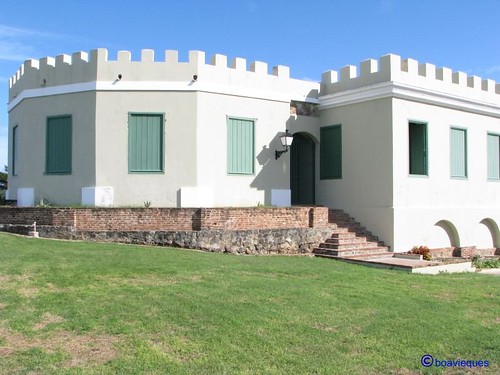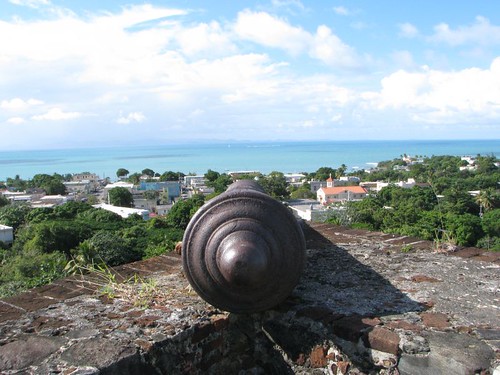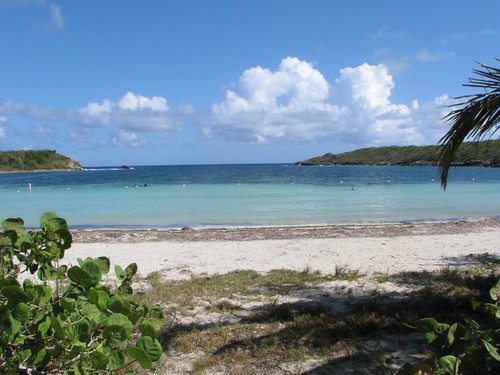
La Isla Nena, named for the Puerto Rican poet Luis Llorens Torres combines beauty and history in an area of \u200b\u200b33 km long by 7.2 wide. Vieques
The word derives from the Indo-West Indian language and means' little land. " For other authors, comes from Bieque, Taino cacique who lived on the island. English settlers from neighboring islands called Vieques Island Crab by the abundance of crabs. However, Vieques first appeared on maps in 1527 under its current name.
dominates the landscape Mount Pirata (301 meters), west, and the Cerro Matias (138 m) to the east. Surrounding the central highlands, populated coastal lagoons and extensive mangrove swamps and coral reefs.
The first inhabitants of the island were the Caribs. Later, French settlers arrived (the first Europeans who occupied Vieques), but the king of Spain considered that Vieques was part of his domain, so that the French were expelled (1647). Later came the English, who built a fort.
urban area and capital of the island is Elizabeth II, the north face the former Puerto de Mulas. Along this stretch of coastline and south toward the center and settle other towns, highlighting the small village of Esperanza. Much of Vieques, primarily the west, was under the jurisdiction of the U.S. Navy (Until 2003). Currently, the vast majority of these lands were transferred to the U.S. Fish and Wildlife U.S.

Antonio Rivera Rodríguez Airport

Fortin Conde de Mirasol , boavieques picture
,
boavieques Photo
Fortin Conde de Mirasol . In Isabel II. Built in 1845 by order of Rafael de Aristegui, Conde de Mirasol and governor of Puerto Rico, to control the entry and attacks by French and British. This is a small two-tier structure, with beamed ceilings and brick walls. The walls were never completed, but can still be seen on a high hill of Isabel II. For some years, since 1898, served as a state prison.
La Casa del Frances. Historical construction of Vieques National Monument. Formerly part of the sugar cane plantation of French Henri Muraille. Its construction dates back to 1910, constituting a typical example of country house at the time. After restoration it was converted into a hotel.
Faro de Punta Mulas . In Puerto Mulas, Isabel II. It was part of a chain of lighthouses built by the English government (siglo XIX). It is a small lighthouse, consisting of an octagonal tower about 15 meters. Designed by the Puerto Rican military engineer José Sanz, following the neoclassical style and includes a ledge around the building.
Malecón La Esperanza La Esperanza . As Elizabeth II, was one of the first settlements of Vieques, later converted into a sugar cane plantation. It houses a small harbor protected by two islands which are home to fishing boats.
Mosquito Bioluminescent Bay . Vieques found in the spectacular phenomenon of micro-organisms produce bioluminescence, which, when agitated, they produce light effects. Due to the conditions of the area, is one of the most spectacular bioluminescent bays that can be visited.
coral reefs. Vieques is a paradise for diving and snorkelling. Reefs Coral are the main attraction of the island. Among the most abundant reef stand edge gaps that arise in direct contact with the coast, and patch reefs, which development occurs in isolated clusters in the coast. Coral reefs in Vieques are more developed in the east and the north coast, between Punta Este and Punta Mulas, dominating the edge type. On the west, between Punta Arenas and Punta Boca, living reefs of the two types, also on the south coast at the entrances of bays, lagoons and Ensenada Honda.
Vieques Beaches

Sun Bay

Hope 
Green Beach / Punta Arenas

Mosquito bay aerial view

Playa Grande

Vieques Sunset
For more information visit Vieques Events
Special thanks to my friend Oscar boavieques known as flickr and co-system administrator of the Flickr group Isla Nena, Vieques Thank you for letting me use some your photos. I invite you to learn their job .





No comments:
Post a Comment